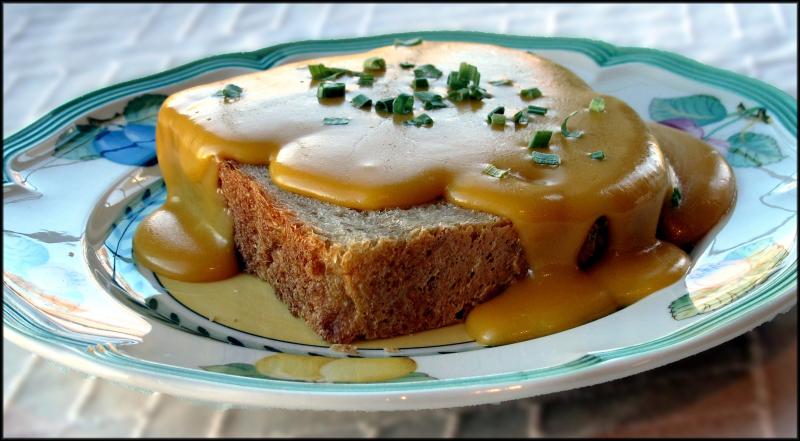Welsh Rarebit a nostalgic nod to Colonial times
On a recent visit to Colonial Williamsburg, we had lunch at Chowning's Tavern, one of many restored buildings on Duke of Gloucester Street. While some of the menu items were quite modern (I don't think they ate portabella sandwiches with creme fraiche on the eve of the American Revolution) they offered others you would find on a Colonial-era table, such as Welsh Rarebit.
The version they served was an excellent rendition of the dish: a rich cheddar cheese sauce melted over a toasted slice of hearty bread. In some older recipes the toast is replaced with zephyrettes (flaky crackers), sippets (similar to seasoned croutons) or rusk (a hard, dry biscuit).
There's a great deal of speculation among food historians about the basis for the original name, Welsh Rabbit, as well as the current name, rarebit. Some suggest the use of "Welsh" was intended as an insult to suggest inferior quality. Counterfeit jewels were called Welsh pearls, and if you styled your hair with your fingers you were said to be using a Welsh comb.
Perhaps Welsh rabbit was the dish typically served when meat wasn't available. Or, it may refer to an urban legend that claims the Welsh weren't allowed to hunt rabbits on the estates of the nobility and were forced to substitute cheese.
How did we came to call the cheesy concoction Welsh rarebit? Rarebit is a completely invented word. It does not mean "choice morsel" or rare bit and only appears in the name of this dish. Perhaps this is just an example of giving simple foods fancy names, like Billingsgate pheasant, which is not poultry, but a type of smoked herring named after London's Billingsgate fish market.
Although there was no rabbit in the original Welsh rabbit, this isn't the only recipe named for something it's not. Hot dogs aren't made from dogs and don't truly resemble dachshunds. Bombay duck is a salted fish. Catsup has no cats, and toad in the hole does not feature frogs. Sweetbreads are neither.
Back to the story of Welsh Rarebit, which first appears in Hannah Glasse's 1747 cookbook as Welch Rabbit along with instructions for variations she calls Scotch Rabbit and English Rabbit. By the late 1700s, Welsh rabbit has become Welsh Rarebit and the new name persists. In Fannie Farmer's 1896 Boston Cooking-School Cookbook, she offers recipes for Oyster Rarebit, Tomato Rarebit and a related dish called English Monkey.
Joy of Cooking, which has been in print since 1931, offers a recipe for Welsh Rarebit that doesn't begin with a roux (flour browned in melted butter). Without a thickening agent, this version is likely to be thin and somewhat runny. I'm not sure if the two variations that follow - The Mackie, with tomato and bacon, or the Blushing Bunny, which includes a can of condensed tomato soup - will be pretty on the plate.
No matter what you choose to call this, there are a few considerations when making Welsh Rarebit. The toasted bread should be grainy and sturdy so it doesn't disintegrate under the cheese. Good-quality cheddar is my first choice, but you'll also be happy with Cheshire (produced in both England and Wales). Ale or porter provides a nutty undertone; Worcestershire sauce and cayenne add a little bite.
Welsh Rarebit was originally served at the end of a multi-course meal as a savory cheese course. Today, it works as a great lunch or brunch dish, especially on a cold afternoon. If you want to add another layer, top the cheese with a poached egg to create a Buck Rarebit - perfect for breakfast.
Welsh Rarebit
1 T butter
1 T flour
1/3 C milk
1/2 C ale
8 oz Cheshire cheese
1 t Worcestershire sauce
1/2 t Dijon mustard
pinch cayenne
1 egg yolk
4 slices whole-grain bread
snipped chives
Melt the butter over very low heat in a heavy saucepan. Add the flour and stir to combine. Continue cooking until the mixture turns golden brown, stirring regularly. Pour in the milk and whisk to remove any lumps. Simmer until thickened slightly, about 5 minutes. Stir in the ale and crumble the cheese into the pan; whisk until melted.
Add Worcestershire sauce, mustard and cayenne. Place the egg yolk in a small bowl and whisk until smooth. Add a generous spoonful of the warm cheese mixture to the egg and whisk quickly to combine. Pour the egg yolk mixture into the pan and stir; cook until heated through. To serve, toast the bread and place a slice on each plate. Ladle cheese sauce over bread slices and garnish with snipped chives. Yield: 4 servings.
Welsh Rarebit Additions
Anchovy
Artichoke
Bacon
Capers
Ham
Oysters
Poached egg
Sautéed mushrooms
Steamed spinach
Tomato puree
Tomato slices
























































